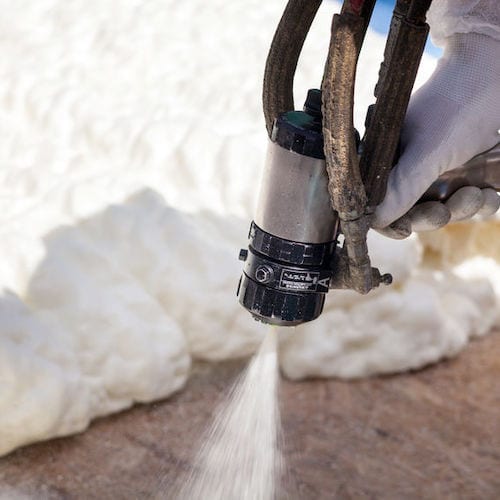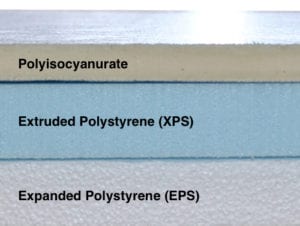
It gets cold outside in the winter but that doesn’t mean it has to be cold inside your house. Using the right kind of insulation in the right way is the key to staying warm and safe indoors. I recently talked about the Pitfalls of Old House Insulation and I’ve written about a variety of different types of insulation including blown-in, spray foam, and mineral wool, but today I want to focus on foam insulation.
Foam insulation can come in a few different forms, the most popular of which is spray foam, but there is also foam board insulation (often called rigid foam insulation). In this post, I’ll give you a break down of all three types and when and where they work best. These are all fine types of foam insulation, but don’t be fooled that they all work in every situation. When poorly matched to your application, some of these can pose major problems.
Spray Foam Insulation
In the last 20 years, spray foam insulation’s popularity has grown immensely and for good reason. It has a very high R-value per inch when compared to other insulations like fiberglass, mineral wool, and blown-in insulations. This high R-value, coupled with an ability to provide excellent air sealing helps a lot of contractors who specialize in new construction meets the more stringent air sealing requirements of the building codes today.
Open-Cell Spray Foam
- R-Value: 3.5 per inch
- Cost $1 to $1.25 per SF
The most affordable of the spray foam options, open-cell spray foam, is used in many applications like roof, walls, and ceilings. Open-cell foam insulation expands greatly upon installation and is fairly soft to the touch, unlike closed-cell foam. Open-cell foam is also vapor permeable which means it does not count as a vapor barrier and needs to have one applied over it. The vapor permeability of open-cell spray foam means that it can take in water and hold it, which can be a real danger. In the case of leaks, open-cell foam will absorb water and hold it against the framing and sheathing elements facilitating mold and rot.
Bottom Line: It’s a great and affordable insulation option when there is no chance of water intrusion, but you’re rolling the dice if you think it might get wet.
Closed-Cell Spray Foam
- R-value: 6.5 per inch
- Cost $2 to $3 per SF
Closed-cell spray foam is the king of the insulations when it comes to both R-value per inch and cost. Nothing else comes close, really. Unlike its open-cell cousin, closed-cell spray foam is not vapor permeable and will not hold water. This makes it an excellent option in case of water intrusion. It also includes binders and glues in many applications that help it to literally glue a structure together. Its strength can help prevent uplift when applied on roof decks and provide shear strength to structures. One downside is that often the blowing agents for closed-cell foam are hydrofluorocarbons, which are not so good for mother nature.
Bottom Line: It’s expensive, but wow, will this get you a structurally sound and well insulated building.
My personal preference on spray-foam insulations is that for new construction, they are an excellent option (if applied correctly, since user error during installation can cause catastrophic results. Learn more here). On historic buildings and remodels, I’m not a fan because the design of older homes especially historic in nature was never meant for this type of insulation and can cause performance problems.
Spray foam is NOT reversible, which is a major problem in historic buildings, which may cause irrevocable damage to historic fabric.
Rigid Foam Insulation
Not all foam insulation is spray foam. Rigid foam insulation is another option for insulation that should be considered, especially since unlike spray foam, it is easily reversible, a major plus for historic structures. Rigid foam insulation come in several varieties and of course, there are different makers of each type.
All of these rigid foam insulation options are usually sold in 4×8 sheets of varying thickness from 1/2″ to 2″ so you can pick and choose the best option for your house.
Expanded Polystyrene (EPS)
- R-value: 3.8 per inch
- Cost: $.26 to $.32 per SF
Expanded polystyrene (EPS), often known as Styrofoam, has been popular for years. It does just as well at insulating coffee cups as it does old houses. While it may have the lowest R-value of the rigid foam options, it does also follow with the lowest cost of any we’ve mentioned so far. There have been newer High-Density EPS products that have managed to bump up the R-value and excel in exterior applications.
Extruded Polystyrene (XPS)
- R-value: 5 per inch
- Cost: $.38 to $.45 per SF
Extruded polystyrene (XPS) rigid foam is usually blue or pink in color and is not quite as rigid as the other foam insulations, which gives it a little more versatility, in my opinion. XPS has no problems with absorbing water, unlike polyiso, which is another mark on the plus column for XPS. It typically does not come faced with foil like the other two types of rigid foam mentioned here.
Polyisocyanurate
- R-value: 6.8 per inch
- Cost: $.65 to $.75 per SF
Polyisocyanurate (polyiso for short) has the highest R-value and (no surprise) correspondingly the highest cost for any rigid insulation. Its R-value does have a tendency to degrade over time with exposure. Typically sold with a radiant barrier of foil on both sides, you also get the benefit of stopping radiant heat with this foam. Read about radiant heat transfer here! Polyiso is essentially the board form of the closed-cell spray we talked about in the first section.
Rigid foam insulation is not something you cut and stuff into the stud bays like fiberglass or mineral wool. Rigid foam insulation is best installed on the exterior of the framing and then the siding is installed over top of it. This may be particularly difficult and expensive for retrofit installations.
Installation on roof decks as a part of a re-roof project often makes the most sense and provides the biggest payback. If you’re going to add 2″ to the height of your roof by decking with rigid foam prior to installing new shingles, you’ll need to make some modifications to the cornice and fascia, but this can be done in ways that don’t impact the overall appearance of the house too much.
Conclusions
It’s really for you to make up your mind as to if foam insulation is right for you, and if so, which type and where. I know, I know, lots of question and not as many answers. My hope is that armed with the information here, you can make a better decision when it does come time to insulate your house. Happy insulating and stay comfy!

Founder & Editor-in-Chief
I love old houses, working with my hands, and teaching others the excitment of doing it yourself! Everything is teachable if you only give it the chance.



I have tried (unsuccessfully) to convince a few contractors here in New Hampshire not to use spray foam on historic buildings for precisely the reasons mentioned here…
I have wondered if one could apply a fabric or film before spraying the foam into cavities so the foam could be later removed – sure would seem like a win-win to me.
Thank you for bringing up the fact that rigid foam insulation is easily reversible if needed. My mother-in-law has been trying to get everything right for the new luxury house that she just bought, and we’re thinking of helping her out. Since the house hasn’t had most of its essentials replaced, rigid foam insulation might be exactly what she needs so she can make adjustments to it whenever she wants. I’ll help her out by checking our area for any insulation contractors that can stop by.
For new construction would you recommend using Polyisocyanurate installed on the exterior of the framing with closed cell spray foam in the wall cavity?
I am having a tiny house built and would like to use Polystyrene to add a sound barrier as well as a thermal break.
Can I apply spray foam insulation on top of 2″ thick xps rigid foam board insulation? The underfloor of my 3 season porch has 2″ rigid board and I’d like to add spray foam on top of that for additional insulation? I have crawl space access. Does the spray foam need to be covered given it has crawl space exposure?
Scott – What do you mean by ‘Performance Problems’ with closed cell spray foam on historic buildings and remodels. I’m considering it for my 1915 stone colonial outside Philadelphia
Mostly moisture issues like high humidity, rot and premature paint failure are created by adding spray foam.
Along the Gulf Coast where we have Formosan termites folks are having a tough time getting an exterminator to treat, monitor and warranty homes that have spray foam. And, they are not renewing contracts if a home has spray foam.
My bedrooms are directly above my garage. The garage ceiling is finished, but without any insulation (1961), so the bedrooms get very cold. It seems like closed-cell spray foam might be the best option to avoid pulling the garage ceiling down, but it’s so expensive. Could I simply affix rigid foam board directly to the existing garage ceiling, or does it really need to be between the layers to be effective? What options/materials should I rule out?
Be careful with closed cell foam. There are hundreds of cases whereby retrofitting closed cell has rendered the home un-usable.
The problem is off-gassing of the foam if not installed properly. Closed cell needs to go on in layers and each layer needs to cure fully before the next is applied. IF an un-cured layer gets covered, it never fully cures and releases somewhat toxic gases that make people very sick. And once that stuff goes in, there really is no going back.
I watched a documentary about a family who needed to have their roof removed in an attempt to remove the foam from between the ceiling joists. IT didn’t help and the family is living in a trailer.
Here’s some good info:
https://www.finehomebuilding.com/2018/11/07/h280-is-using-closed-cell-foam-worth-the-trade-offs
Absolutely agreed! Install correctly and strategically or don’t do it at all.
Sounds like every single building product that you’re describing. Do it right or it’s completely useless for its intended purpose.
I’m a commercial masonry contractor, we’ve done $20 mil+ subcontracts with million dollar exterior sprayfoam budgets. In our experience, exterior sprayfoam is an absolute disaster. The wind, the rain and the prep are a nightmare if the stars do not align in your favor. For interior, it is great. I’ve seen 10+ schools go months over construction schedule due to exterior sprayfoam alone. It’s a good product when used correctly. Just don’t use it on the exterior. Rigid XPS or Polyiso are the way to go. The other subs will thank you as well.
Great article! FYI, you have EPS and XPS reversered on the labeled photo.
Good catch! Got it fixed now!
We’ve had excellent results using sheep’s wool insulation in our 1860 house. It’s relatively expensive but has enormous benefits, especially in that it’s safe and easy to handle.
Great choice for an old house!